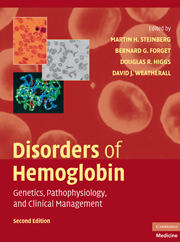Book contents
- Frontmatter
- Contents
- List of Contributors
- Foreword, by H. Franklin Bunn
- Preface
- Introduction, by David J. Weatherall
- SECTION ONE THE MOLECULAR, CELLULAR, AND GENETIC BASIS OF HEMOGLOBIN DISORDERS
- SECTION TWO PATHOPHYSIOLOGY OF HEMOGLOBIN AND ITS DISORDERS
- 8 Rheology and Vascular Pathobiology in Sickle Cell Disease and Thalassemia
- 9 The Erythrocyte Membrane
- 10 The Biology of Vascular Nitric Oxide
- 11 Mechanisms and Clinical Complications of Hemolysis in Sickle Cell Disease and Thalassemia
- 12 Animal Models of Hemoglobinopathies and Thalassemia
- SECTION THREE α THALASSEMIA
- SECTION FOUR THE β THALASSEMIAS
- SECTION FIVE SICKLE CELL DISEASE
- SECTION SIX OTHER CLINICALLY IMPORTANT DISORDERS OF HEMOGLOBIN
- SECTION SEVEN SPECIAL TOPICS IN HEMOGLOBINOPATHIES
- SECTION EIGHT NEW APPROACHES TO THE TREATMENT OF HEMOGLOBINOPATHIES AND THALASSEMIA
- Index
- Plate section
- References
9 - The Erythrocyte Membrane
from SECTION TWO - PATHOPHYSIOLOGY OF HEMOGLOBIN AND ITS DISORDERS
Published online by Cambridge University Press: 03 May 2010
- Frontmatter
- Contents
- List of Contributors
- Foreword, by H. Franklin Bunn
- Preface
- Introduction, by David J. Weatherall
- SECTION ONE THE MOLECULAR, CELLULAR, AND GENETIC BASIS OF HEMOGLOBIN DISORDERS
- SECTION TWO PATHOPHYSIOLOGY OF HEMOGLOBIN AND ITS DISORDERS
- 8 Rheology and Vascular Pathobiology in Sickle Cell Disease and Thalassemia
- 9 The Erythrocyte Membrane
- 10 The Biology of Vascular Nitric Oxide
- 11 Mechanisms and Clinical Complications of Hemolysis in Sickle Cell Disease and Thalassemia
- 12 Animal Models of Hemoglobinopathies and Thalassemia
- SECTION THREE α THALASSEMIA
- SECTION FOUR THE β THALASSEMIAS
- SECTION FIVE SICKLE CELL DISEASE
- SECTION SIX OTHER CLINICALLY IMPORTANT DISORDERS OF HEMOGLOBIN
- SECTION SEVEN SPECIAL TOPICS IN HEMOGLOBINOPATHIES
- SECTION EIGHT NEW APPROACHES TO THE TREATMENT OF HEMOGLOBINOPATHIES AND THALASSEMIA
- Index
- Plate section
- References
Summary
INTRODUCTION
Hemoglobinopathies, including the thalassemia syndromes and sickle cell disease, are complex disorders with protean manifestations. Their pathophysiology is influenced by environmental and genetic factors in addition to the pleiotropic effects of the globin gene mutations themselves. The erythrocyte membrane plays a critical role in these disorders because of the effects of its structural and functional perturbations and alterations in ion and water homeostasis regulated by membrane proteins. The first portion of this chapter reviews the structural and functional characteristics of the erythrocyte membrane; this is followed by a review of the alterations in ion and water homeostasis observed in the erythrocytes of sickle cell disease and thalassemia.
MEMBRANE STRUCTURE AND FUNCTION
The erythrocyte membrane is a complex, multifunctional structure. Although providing a protective layer between hemoglobin and other intracellular components and the external environment, it provides the erythrocyte with the deformability and stability required to withstand its travels through the circulation. The erythrocyte is subjected to high sheer stress in the arterial system, dramatic changes in size in the microcirculation, and wide variations in tonicity, pH, and pO2 as it travels throughout the body. It facilitates the transport of cations, anions, urea, water and other small molecules in and out of the cell, but denies entry to larger molecules, particularly if charged. A unique anucleate cell, the erythrocyte has a limited capacity for self-repair.
Membrane Structure
The erythrocyte membrane is composed of a lipid bilayer linked to an underlying cortical membrane skeleton.
- Type
- Chapter
- Information
- Disorders of HemoglobinGenetics, Pathophysiology, and Clinical Management, pp. 158 - 184Publisher: Cambridge University PressPrint publication year: 2009
References
- 2
- Cited by



